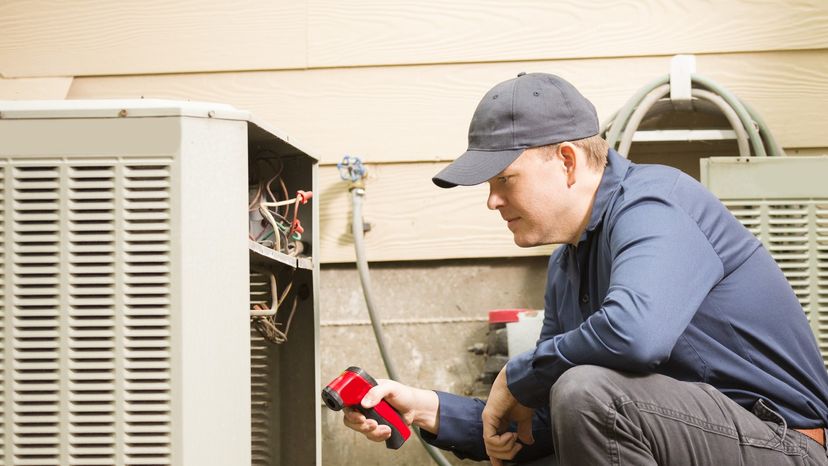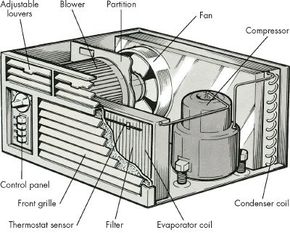Room air conditioners, also called window units, work the same way central air conditioners do. They are smaller than central systems and often more expensive to operate. Depending on its size, a room unit may cool only the room in which it's located, or it may be able to cool adjoining rooms as well.
Sandwiched between the coils are a compressor, two fans, a motor, and thermostat controls. Dirt is the biggest enemy of window air conditioners; it can lower the efficiency of the evaporator coil, block the operation of the fan that blows out the cool air, clog filters, and block drain ports.
The coils, the compressor, and the motor of a room air conditioner are sealed components, so any repairs to them should be left to a professional service person. However, you can make minor repairs, and regular maintenance will keep your unit running well. When extensive repairs are needed, you can also save the cost of a service call by removing the air conditioner from its mounting and taking it to the repair shop.
During the winter, room air conditioners should be protected from the elements. Either remove the unit from its mounting and store it or cover the outside portion of the unit with a commercial room air conditioner cover or with heavy plastic sheeting, held in place with duct tape.
Caution: Before doing any work on a room air conditioner, make sure it's unplugged. Room air conditioners have either one or two capacitors, located behind the control panel and near the fan. Capacitors store electricity, even when the power to the unit is turned off. Before you do any work on an air conditioner, unplug it and discharge the capacitor or you could receive a severe shock. The unit's owner's manual will show the location of capacitors and tell how to discharge them. Otherwise, let an air conditioning technician do it.
Maintaining Key Components
The filter, power cord, coils, switch, thermostat, drain ports, and fan are important to service on a routine basis to avoid larger problems. Below are guidelines on how to maintain these key parts.
Filter
At the beginning of every cooling season and once a month during the season, remove the front grille and clean or replace the filter. If you live in a very dusty area, clean or replace the filter more often. Most room air conditioners have a washable filter that looks like sponge rubber.
Clean the filter with a solution of mild household detergent and water; rinse well. Let the filter dry completely before reinstalling it. Some units have a throwaway filter, similar to a furnace filter. When this type of filter becomes dirty, replace it with a new one of the same type.
Power Cord
The power cord that connects the air conditioner to the wall outlet may become worn and fail to supply electricity to the unit. To check the cord, remove the control panel. Unscrew the cord terminals and then attach a test wire across the bare lead wires.
Hook the clips of a volt-ohm-milliammeter (VOM) set to the RX1 scale to the prongs of the cord's plug. If the meter reads zero, the cord is functioning. If the meter reads higher than zero, replace the cord.
Evaporator and Condenser Coils
Clean the evaporator and condenser coils at the beginning of the cooling season and every month during the season. If you live in a very dusty area, clean the coils more often. Use a vacuum cleaner on these components.
If the fins on the coils are bent, straighten them with a fin comb, sold at most appliance parts outlets. A fin comb is designed to slide into the spaces between the fins. Use it carefully as the fins are made of light-gauge aluminum and are easily damaged.
Switch
The selector switch, located directly behind the control panel, turns the unit on. If the air conditioner does not run at any setting, and it is receiving power, chances are the switch is faulty. To correct the problem, remove the control panel and locate the switch. Check the switch terminals for burnt insulation or burn marks on the terminals. If you see any indication of burning, replace the switch with a new one of the same type.
The switch is held to the control panel or frame with screws; unscrew it and connect the new one the same way. If you determine the problem may not be the switch, call a professional service person.
Maintaining the thermostat and drain ports on your home air-conditioning window unit is vital to keep the whole system working properly. It won't be a difficult or burdensome task if you folllow the guidelines mentioned below.

